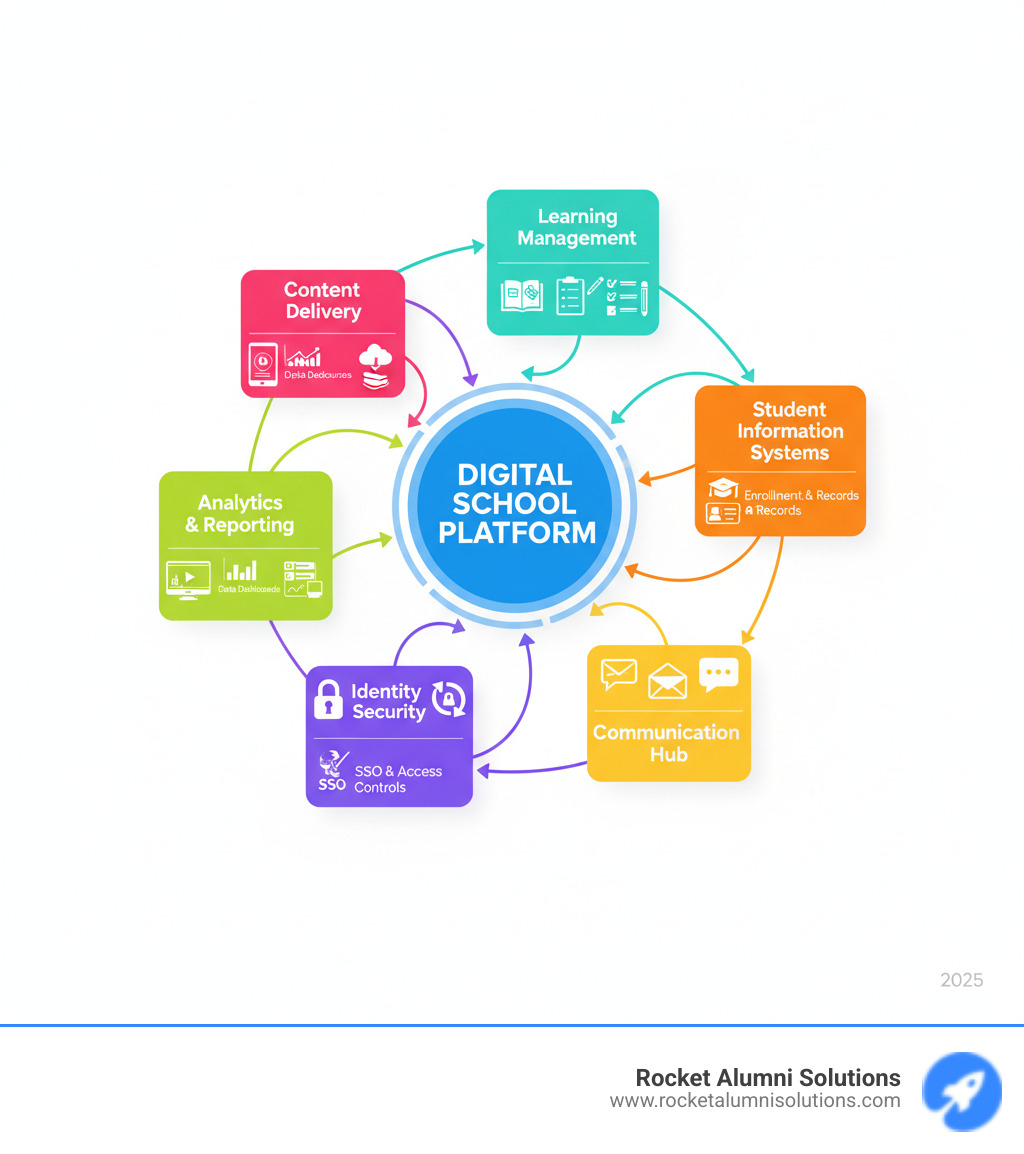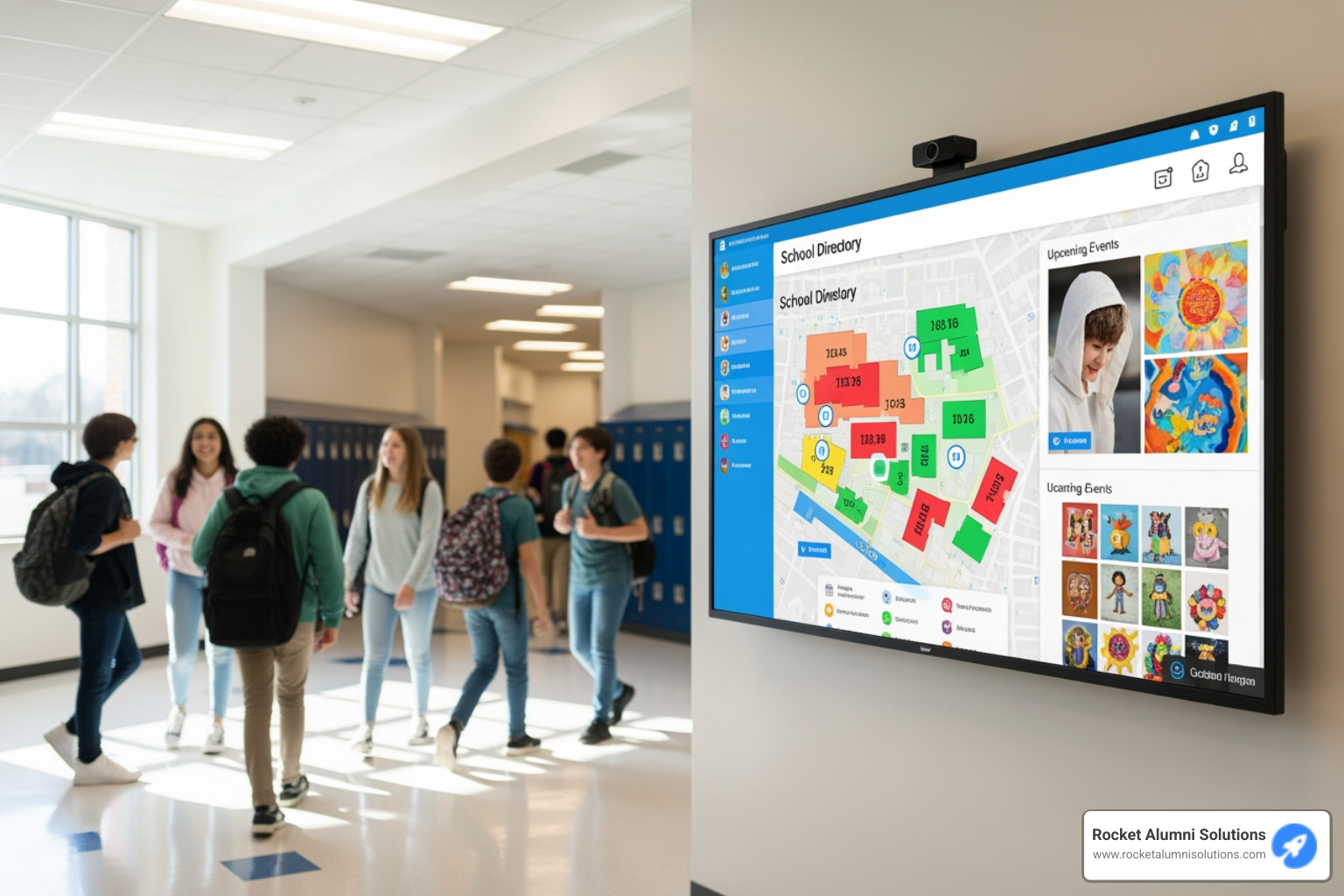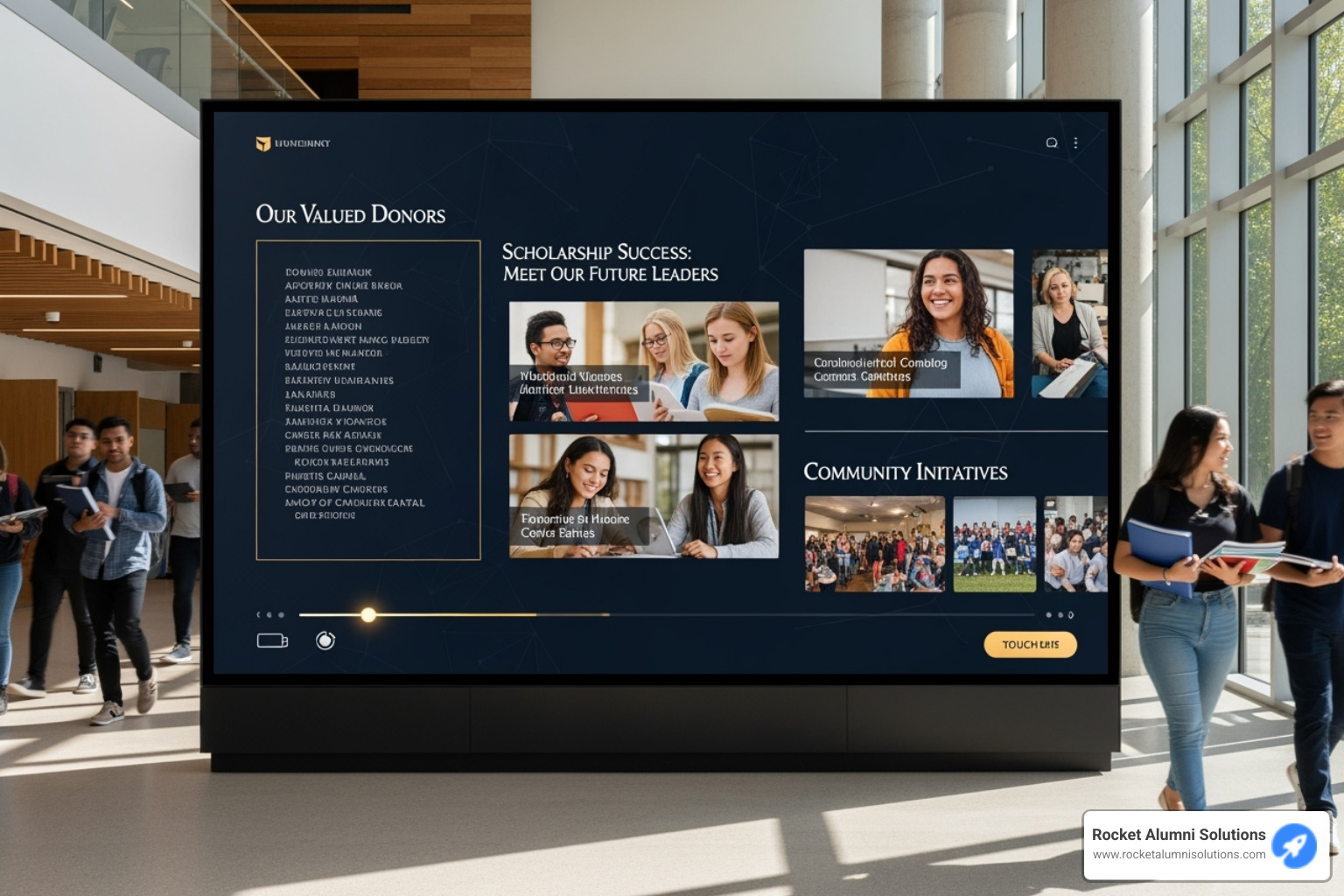A digital school platform is a unified technology solution integrating learning management, communication, and administrative tools into a centralized hub for the school community. These platforms combine educational functions—from lesson delivery and student assessment to parent communication and data analytics—into one cohesive system.
Key components of digital school platforms include:
- Learning Management Systems (LMS) - Course content, assignments, and grading
- Student Information Systems (SIS) - Enrollment, attendance, and academic records
- Communication portals - Messaging between teachers, students, and families
- Identity management - Single sign-on (SSO) and secure access control
- Analytics and reporting - Data insights for improved decision-making
- Content delivery - Digital textbooks, videos, and interactive materials
This shift from traditional tools to integrated digital solutions reflects education's rapid evolution. As one industry expert notes, "Teaching and learning are continuously evolving," with students increasingly preferring e-learning. Today's platforms support hundreds of millions of educators, students, and families worldwide across a wide range of tools and services—reflecting the scale and momentum behind digital learning.
These unified systems address critical challenges facing K-12 education: fragmented technology, inefficient communication, and the need for personalized learning at scale. By providing a single digital identity and centralized access point, modern platforms eliminate the complexity of juggling multiple separate tools.
I'm Chase McKee, Founder & CEO of Rocket Alumni Solutions, where we've helped schools transition from static recognition displays to interactive digital experiences that engage entire communities. Through building our digital school platform solutions, I've seen how unified technology transforms not just learning, but the entire school culture and community.

Understanding the Core Components and Types
Think of a digital school platform as the central nervous system of modern education. Just as our bodies work best when all systems communicate seamlessly, schools thrive when their technology is unified. This isn't just about making life easier - though it certainly does that - it's about creating something much more powerful.
The magic happens through unified platform benefits that transform how schools operate. When everything connects, students can focus on learning instead of juggling multiple passwords. Teachers spend more time teaching and less time switching between apps. Administrators get the complete picture they need to make smart decisions.
Single Sign-On (SSO) is like having one master key for your entire digital school. Students and teachers use just one set of login credentials to access all their educational applications. No more forgotten passwords or time wasted logging into different systems.
But the real power comes from application integration and data synchronization. Picture this: a student completes a math quiz, and their score automatically updates in the gradebook, triggers personalized practice recommendations, and sends progress updates to parents - all without anyone lifting a finger. This seamless flow of information creates what educators call "instant access to secure digital learning experiences."
The foundation of all this connectivity rests on a layered security approach. Schools can offer easy access while maintaining robust protection for sensitive student data. It's like having multiple locks on your front dooreach layer adds protection without hindering authorized users.
Every effective digital school platform brings together five essential functions that keep schools running smoothly:
Learning Management Systems (LMS) serve as the digital classroom where education comes alive. Teachers deliver course content, assign homework, facilitate discussions, and track student progress all in one place. Modern LMS platforms offer adaptive learning that adjusts to each student's pace and style. Some platforms boast over 16,000 pieces of educational content, giving teachers an incredible toolkit for engaging lessons.
Student Information Systems (SIS) act as the school's memory bank. They manage everything from enrollment and attendance to academic records and disciplinary actions. This centralized approach means authorized staff can access the information they need while maintaining strict privacy standards.
Content delivery has evolved far beyond simple file sharing. Today's platforms deliver interactive videos, quick quizzes, and engaging challenges that keep students motivated. At Rocket Alumni Solutions, we've seen how innovative content delivery transforms school culture through our Digital Yearbook Experience Innovations, which showcase student achievements in dynamic, interactive ways.
Communication portals create the connections that make school communities thrive. These secure channels enable messaging between teachers, students, parents, and administrators. Whether it's daily announcements, individual check-ins, or group discussions, effective communication keeps everyone in the loop.
Analytics and reporting turn raw data into actionable insights. These tools help educators identify learning trends, personalize instruction, and measure outcomes. When teachers can see exactly where students are struggling or excelling, they can adjust their approach to help every student succeed.
The world of digital school platforms offers several approaches, each with its own strengths:
Identity Management Platforms specialize in creating secure, unified access across all school systems. These platforms ensure every student and staff member has one digital identity that works everywhere, simplifying access while strengthening cybersecurity.
Learning Experience Platforms (LXP) put personalized learning at the center. Unlike traditional systems, LXPs use AI to adapt content and recommendations to individual learners. They focus on keeping everyone connected - teachers, administrators, students, and families - in what educators call "the learning loop."
Content Management Systems (CMS) excel at creating, managing, and delivering digital content. In schools, this ranges from course materials and digital textbooks to interactive displays of student achievements. These systems make it easy for educators to organize and share rich media content.
All-in-one unified suites aim to be the Swiss Army knife of educational technology. These comprehensive platforms combine email, calendars, video conferencing, document creation, and learning management into single, integrated solutions. They emphasize collaboration and productivity while extending learning opportunities beyond school walls.
The key is finding the right fit for your school's unique needs and goals. Each type offers different strengths, and the best choice depends on your community's priorities and technical requirements.

The magic of a digital school platform isn't just in its technologyit's in how it transforms the daily lives of everyone in our school communities. When students enjoy interactive lessons, teachers find more time for teaching, and parents stay connected to their child's education, we witness the power of unified digital solutions.
These platforms don't just digitize old processes. They create entirely new ways for students to engage, teachers to support, administrators to lead efficiently, and families to stay involved. The result? A learning ecosystem where everyone thrives together.
Enhancing Student Learning and Engagement
The shift to personalized learning paths has been a game-changer for student success. Instead of forcing every student through identical lessons at the same pace, digital platforms use data to adapt content to each learner's unique needs. Students who need extra support get it automatically, while those ready for challenges receive advanced material that keeps them motivated.
Interactive content and gamification have revolutionized how students experience learning. Modern platforms incorporate dynamic videos, quick quizzes, and motivating challenges that make education feel more like play than work. The results speak for themselves9 out of 10 students report staying more focused and motivated thanks to these interactive formats.
What's even more exciting is how these tools improve actual learning outcomes. 92% of students show better understanding of their lessons through structured, progressive resources. Students also develop stronger student agency, taking ownership of their learning journey as they create, reflect, and share their work with confidence.
The data on academic improvement is compelling. With personalized results tracking, 85% of users target their revisions more effectively. This focused approach leads to real grade improvements, with students seeing an average increase of +3.2 points from their first quarter performance.
Digital platforms also bring the world into every classroom through real-world connections. Virtual field trips transport students to places they might never otherwise visit. Students can take a virtual field trip to explore solar telescopes and find the wonders of space science firsthand, making learning both relevant and unforgettable.
Empowering Teachers and Administrators
Our educators deserve tools that amplify their impact rather than burden them with busy work. Digital school platforms deliver exactly that through intelligent automation and streamlined workflows.
Automated grading and lesson planning tools powered by AI are changing how teachers spend their time. Instead of drowning in paperwork, educators can focus on building relationships with students and crafting engaging experiences. Numerous platforms offer robust AI teacher tools for generating standards-aligned lesson plans and assessments, helping educators reclaim precious hours each week.
The impact on teacher wellbeing is remarkable. Many educators report saving 7-10 hours each week on administrative tasks, directly addressing the burnout crisis facing our profession. When teachers have more time and energy, everyone benefits.
Data-driven insights give administrators powerful visibility into student learning trends and school performance. Rather than making decisions based on gut feelings, leaders can use real analytics to improve academic growth and ensure equity for all students. This centralized management approach streamlines everything from scheduling to resource allocation.
Streamlined communication keeps everyone connected without overwhelming inboxes or missed messages. Important announcements reach the right people instantly, and collaboration happens naturally within the platform.
Fostering School-Home Communication
The strongest student success stories happen when schools and families work as true partners. Digital school platforms make this partnership easier and more meaningful than ever before.
Real-time progress updates keep parents continuously informed about their child's academic journey. Instead of waiting for quarterly report cards, families can see grades, attendance, and assignment completion as it happens. This ongoing visibility helps parents provide timely support when needed.
Secure messaging and digital portfolios create safe spaces for meaningful conversations between teachers and families. These platforms showcase student work and progress over time, giving parents a window into their child's daily learning experiences. One touching example shows how platform messages translated into a parent's native language brought tears of joy, creating a powerful connection to their child's classroom.
The result is dramatically increased parent involvement and stronger family engagement. When parents can easily track progress through intuitive dashboards and participate in online parent-teacher meetings, they naturally become more invested in their child's education.
Schools are also finding creative ways to celebrate achievements and build community pride. Digital displays of student accomplishments and school memories help families feel more connected to the broader school culture. Our own Interactive Digital Yearbook Solution exemplifies how technology can preserve and share these precious moments that bind school communities together.

We're living through an exciting time in education. Artificial Intelligence isn't just changing how we work and play it's revolutionizing how we learn and teach. The integration of AI into digital school platform technologies represents one of the most significant shifts in education since the internet itself arrived in classrooms.
What makes this change so remarkable is how AI is making personalized learning possible at scale. Instead of one-size-fits-all education, we're moving toward systems that truly understand each student's unique needs and adapt accordingly. This isn't science fiction anymore it's happening right now in schools around the world.
The emerging trends we're seeing point toward a future where generative AI and machine learning work hand-in-hand with educators to create richer, more engaging learning experiences. Predictive analytics help teachers identify students who might need extra support before they fall behind. These aren't just fancy buzzwords they're tools that are genuinely improving educational outcomes and helping students develop the future-ready skills they'll need in tomorrow's world.
The role of AI in modern digital school platform solutions is both practical and transformative. Think of AI as a tireless teaching assistant that never sleeps, never gets frustrated, and can help dozens of students simultaneously.
Personalized learning has become AI's strongest suit in education. These systems analyze how each student learns best whether they prefer visual content, need more practice with certain concepts, or learn better with shorter lessons. For example, modern AI assistants can personalize learning experiences and deliver insights that help teachers understand exactly what each student needs.
AI-powered tutors are changing the game for students who need extra help. These digital assistants can provide immediate feedback on assignments, answer questions at 2 AM when human teachers aren't available, and even help students debug their coding projects. It's like having a patient, knowledgeable tutor available 24/7.
Perhaps most importantly for our overworked educators, AI handles many automated administrative tasks that used to eat up precious teaching time. Platforms can now generate lesson plans, create quiz questions, draft parent communications, and even help with individualized education programs. Many schools report saving 7-10 hours each week time teachers can spend actually teaching and connecting with students.
Content creation assistance has become a game-changer too. Instead of spending hours creating worksheets or finding appropriate reading materials, teachers can work with AI to generate diverse educational content quickly. This frees up their creative energy for the uniquely human aspects of teaching that AI can't replicate.
AI is also making significant strides in accessibility improvements. Real-time translation helps non-English speaking families stay connected to their children's education. Speech-to-text and text-to-speech tools ensure students with different learning needs can access the same content. These features aren't just nice to have they're leveling the playing field for all learners.
Emerging Trends and Future Directions
The future of digital school platform technologies is unfolding before our eyes, and it's more exciting than we could have imagined just a few years ago.
Immersive learning through AR and VR is moving beyond the experimental phase. Students can now walk through ancient Rome, manipulate 3D molecular structures, or practice public speaking in a virtual auditorium. These aren't just cool tech demos they're proven ways to help students understand complex concepts by experiencing them firsthand.
Micro-learning is gaining momentum as educators recognize that breaking complex topics into bite-sized, digestible pieces often works better than traditional lengthy lessons. Think dynamic videos followed by quick quizzes, or short interactive challenges that keep students engaged without overwhelming them. This approach respects how our brains actually process and retain information.
The concept of lifelong learning portfolios is becoming increasingly important as the job market evolves rapidly. Future platforms will help students build comprehensive records of their skills, achievements, and experiences that go far beyond traditional transcripts. These digital portfolios will grow with learners throughout their entire careers, documenting everything from high school robotics competitions to professional certifications decades later.
Perhaps most critically, we're seeing a renewed emphasis on digital citizenship. As students spend more time in digital environments, teaching them to steer online spaces safely, responsibly, and ethically has become as important as traditional subjects. Schools are integrating digital citizenship into their core curriculum, recognizing that these skills are essential for success in our connected world.
Excellent resources already exist to help schools tackle this challenge, providing students with practical strategies to steer their online lives safely. The change we're witnessing isn't just about better technology it's about creating more human-centered education experiences that prepare students not just for tests, but for life in an increasingly complex world.

Selecting the right digital school platform is one of those decisions that keeps school administrators awake at night – and rightfully so. This isn't just about buying software; you're choosing the technological foundation that will shape how your entire school community learns, teaches, and connects for years to come. The good news? With the right approach, you can find a platform that truly serves everyone.
Think of it like choosing a new home for your school's digital life. You want something that's comfortable for teachers, engaging for students, accessible for parents, and manageable for your IT team. It needs to grow with you, stay secure, and actually make life easier rather than more complicated.
The key to making this decision successfully lies in taking a systematic, thoughtful approach that puts your community's needs first.
Start by defining your goals and current challenges. Before you even look at a single product demo, sit down with your team and honestly assess what you're hoping to achieve. Are you trying to boost student engagement? Streamline teacher workflows? Improve parent communication? Maybe you're dealing with too many separate systems that don't talk to each other. Understanding your "why" will help you evaluate whether a platform's features actually solve your real problems.
Involve everyone who will use the system. A digital school platform affects teachers, students, parents, administrators, and IT staff – so their voices need to be heard during selection. Teachers can tell you whether a gradebook interface makes sense. Students can share what keeps them engaged. Parents can explain what communication tools actually help them stay involved. This input isn't just nice to have; it's essential for choosing something people will actually adopt and use effectively.
Experience the platforms through demos and trials. Reading feature lists is one thing, but actually clicking through a platform is completely different. Most providers offer demos or free trials, and you should take advantage of these opportunities. Have different team members test the same platform and compare notes. Does the interface feel intuitive? Can you find what you need quickly? Do the promised features actually work as advertised?
Check integration capabilities carefully. Your new platform won't exist in isolation – it needs to work seamlessly with your existing student information system, library software, specialized learning apps, and other tools your school already uses. Platforms that offer comprehensive integration, like those that provide "one integration that works everywhere," can save you countless headaches and ensure data flows smoothly between systems.
Prioritize user-friendliness above all else. The most feature-rich platform in the world is worthless if people find it too complicated to use. Look for systems that are genuinely intuitive – ideally ones that new users can learn quickly without extensive training. Some platforms pride themselves on being "user-friendly and easy-to-use, learnable in less than an hour," and this kind of simplicity often leads to better adoption rates.
Here's a practical comparison framework for evaluating your options:
| Feature Category | Key Considerations |
|---|
| Security | FERPA compliance, data encryption, access controls, regular security updates |
| Scalability | Can grow with enrollment, handles peak usage, flexible licensing options |
| AI Features | Personalized learning, automated grading, content recommendations, accessibility tools |
| Support | Training resources, technical support availability, user community, documentation quality |
| Cost | Total cost of ownership, hidden fees, value for money, budget sustainability |
Addressing Data Privacy and Security
When it comes to student data, there's no room for compromise. Digital school platform security isn't just about preventing hackers – it's about maintaining trust with families and complying with strict educational privacy laws.
FERPA compliance is non-negotiable. The Family Educational Rights and Privacy Act protects student educational records, and your platform must meet these standards. This means proper data handling, secure storage, and clear policies about who can access what information. Don't just take a vendor's word for it – ask for documentation of their compliance measures.
Student data protection goes beyond basic security. Look for platforms that encrypt data both in storage and in transit, offer regular security audits, and have clear data breach response procedures. The best platforms also give you control over your data, including the ability to export it if you ever need to switch systems.
Robust access controls ensure the right people see the right information. Teachers should access their class data, parents should see their child's information, and administrators should have broader access as needed. Single sign-on (SSO) systems make this easier to manage while maintaining security.
Modern platforms should meet WCAG 2.1 AA accessibility standards. This ensures that students, parents, and staff with disabilities can fully use the system. Accessibility isn't just good practice – it's often legally required. For detailed guidance on these requirements, you can learn more about ADA compliance for school websites.
Comprehensive cybersecurity measures protect against evolving threats. This includes protection against malware, spam filtering, regular security updates, and monitoring for unusual activity. The digital landscape changes quickly, so your platform provider should stay current with emerging security challenges.
The goal isn't to find the perfect platform – it's to find the right platform for your school community. Take your time, involve the right people, and choose something that will serve your students, teachers, and families well for years to come.
Conclusion
As we reach the end of our journey exploring digital school platforms, one thing becomes crystal clear: education's future isn't just digital—it's beautifully connected. We've seen how these powerful platforms bring together everything a school community needs, from learning management and student records to communication tools and data insights, all working together like pieces of a perfectly fitted puzzle.
The change happening in our schools is remarkable. Students are more engaged than ever, with 92% reporting better understanding through interactive learning. Teachers are saving 7-10 hours each week thanks to AI-powered tools. Parents feel more connected to their children's education through real-time updates and secure messaging. And administrators finally have the data they need to make smart decisions.
Looking ahead, the possibilities are endless. AI tutors will provide personalized support around the clock. Virtual reality will transport students to ancient Rome or inside a human cell. Micro-learning will make complex topics digestible for every learning style. And through it all, we'll be teaching our students to steer the digital world safely and responsibly.
Choosing the right digital school platform isn't just about buying software—it's about investing in your community's future. It requires careful planning, involving everyone from teachers to parents, and always keeping student privacy and security at the forefront.
At Rocket Alumni Solutions, we see the bigger picture. Just as comprehensive digital platforms unite learning, teaching, and communication, our solutions unite recognition and celebration. We believe every school deserves to showcase its unique story and honor its achievements in ways that inspire pride and belonging.
Whether it's changing static trophy cases into dynamic displays or creating interactive yearbooks that families treasure forever, we're here to help you build that connected school culture. Your students, alumni, and community deserve recognition that's as innovative as your teaching methods.
The future of education is integrated, engaging, and inspiring. Together, we're not just preparing students for tomorrow—we're creating the tools and traditions that will define it. Find how our Digital School Hall of Fame can celebrate your legacy, or explore our digital yearbook solutions to capture this year's memories in ways that will amaze your community.



















































































































































































































































































































